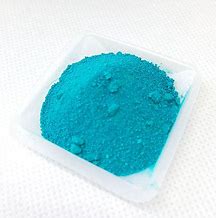COPPER BIS GLYCINATE//
COPPER GLYCINE SULPHATE
Copper (II) glycinate refers to the coordination complex of copper (II) with two equivalents of glycinate. We at Jiaan Biotech manufacture Copper Trace Elemental form in chelated complex in 2 forms of Glycine as COPPER GLYCINATE and COPPER GLYCINE SULPHATE form.
We are being the leading Manufacturer of Copper Glycinate in India
Copper is required to absorb and utilize iron and to generate ATP, the energizing fuel. Copper is required for the synthesis of hormones and collagen. Copper supports enzymes that protect cells from oxidative damage and promotes healthy skin and hair.
PROPERTIES:
- Consistent content of trace elements
- Uniform particles
- Excellent flowability
- No dust or lumps
- Easy to handle
- Perfect miscibility and water solubility
- No bad odor

BENEFITS:
- Nutraceutical and Pharmaceutical Industry:
- Bioavailability: Copper glycinate is highly bioavailable, making it a preferred source of dietary copper supplementation in human and animal nutrition, which is a source of copper, which is often added to multivitamins and health drinks. It also helps in forming collagen (important for bones and tissues)
- Health Benefits: It supports enzyme functions, promotes red blood cell production, and aids in the maintenance of connective tissues, Hence, protecting it from damage which can be marketed in dietary supplements. Keeping nerve cells healthy and Supporting the immune system
- AGRICULTURE
- Fungicide : Copper glycinate sulfate is used to control fungal diseases in crops and plants
- Essential micronutrient: Copper is an essential micronutrient for plants, and it helps with photosynthesis, respiration, and antioxidant activity
- Toxicity: Too much copper can be toxic to plants, and can negatively impact germination, growth, and photosynthesis
- Response to copper: Some crops, like wheat, alfalfa, and tomatoes, respond well to copper fertilization when conditions are deficient
- Examples of crops that respond to copper :
- wheat, alfalfa, barley, oats, tomatoes, onions, lettuce, and fruits.
- ANIMAL FEED SUPPLEMENTS:
- Connective tissue: Copper glycinate helps repair connective tissue, which is important for skin and cardiovascular health
- Red blood cells: Copper glycinate helps produce hemoglobin and red blood cells
- Energy metabolism: Copper glycinate helps activate enzymes that are important for energy metabolism
- Antioxidant: Copper glycinate helps prevent oxidation of fatty acids
- Copper deficiency
- Copper deficiency in animals can cause anemia, reduced growth, and impaired immune function and Other symptoms may include:
Poor conception, Rough coat, Hair discoloration, Heart failure, Diarrhea , Easily fractured bones
- Feed Additive: Used as a trace mineral supplement in animal feed to promote growth, improve immunity, and enhance reproduction in livestock and poultry
- COSMETICS: It is also a key component in the pigmentation of hair and skin.
- Skin Benefits: Copper glycinate can be used in anti-aging and skincare products due to its role in promoting collagen synthesis and maintaining skin elasticity.
- Antioxidant Properties: Its ability to neutralize free radicals makes it a valuable ingredient in formulations aimed at reducing oxidative stress on the skin.
- Metal Plating and Surface Treatments:
- Stabilizer: The chelation of copper with glycine can be used in electroplating processes to ensure a controlled release of copper ions, improving plating uniformity and reducing contamination.
- Corrosion Resistance: Inhibits corrosion on metal surfaces, particularly in environments where copper ions are required for protection.
- Water Treatment:
- Algaecide: Copper Glycinate is used to control algae growth in water bodies, such as reservoirs and swimming pools, due to its solubility and effectiveness at low concentrations.
- Eco-Friendliness: The chelated form prevents excessive accumulation of free copper ions, reducing environmental toxicity.

